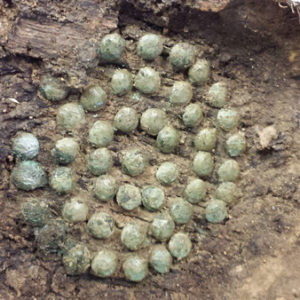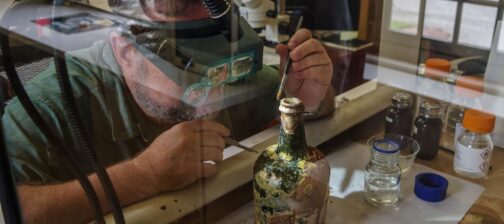The wooden cover decorated with tacks that archaeologists excavated in May 2015 may be the cover to a treasure box called a casket.
“It would hold someone’s personal, important, or valuable items. In some cases they could hold documents because these caskets had locks on them,” said Jamestown Rediscovery Senior Conservator Dan Gamble.
Gamble spent three weeks carefully cleaning the object after it came out of the ground. The artifact came from a cellar at the corner of the 1608 James Fort extension, just north of the 1907 Memorial Church. The team found about 20 loose copper alloy tacks in the cellar fill, and then Staff Archaeologist Mary Anna Richardson found a grouping of tacks attached to the remnants of a flat piece of wood.
Wood usually does not survive in the acidic soil, but the copper tacks contain salts which kill the bacteria in the soil that would normally eat up the wood. The archaeologists pedestaled the find, which means they wrapped it with about two inches of its supporting soil to transport it into the lab for more careful excavation. Conservators sprayed the wood and tacks with Rhoplex to protect the artifact from further deterioration in the air, then wrapped the artifact in cheesecloth.
“When we went into it, we know what we were up against because we could see the ends of the tacks through the cheesecloth that we wrapped the artifact in. What we didn’t know was how much wood was present,” Gamble said.
After Gamble removed the artifact from the section of soil, what remained was a section 4 inches wide and 6 inches long that has a pyramid pattern of nine tacks at the top and a circular pattern of 57 tacks at the bottom. Beyond the tacks, the section includes fragments of wood, leather, and iron.
“The exciting thing is the fact that we were able to keep it all intact. That’s what drives you: that we can excavate something so fragile and help it to survive,” Gamble said.
The leather on the section of soil could be from a strap used to hold the box closed, and the tiny iron fragment could be from a latch. There was thought that this artifact could be a book cover because some books of the era did have wooden covers and ornate hardware to protect the pages from damage. Book hardware came into use during the 14th century in Europe and was still in use in the early 17th century when the colonists arrived at Jamestown. Twenty years of excavations at the James Fort site have yielded more than 100 pieces of book hardware. But they are just that: artifacts made from copper alloy that were both functional and ornamental components once attached to books. The paper and other book parts long ago disintegrated in the soil.
Gamble said, “It could still be a book cover, but there’s nothing in there that says it’s a book. There was no latch mechanism or cloth or leather under the tacks.”
related images
- The wooden box lid after conservation
- A closeup of the copper alloy tack design







